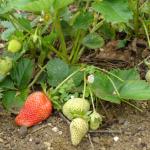Growing Strawberries (from seeds)
Fragaria : Rosaceae / the rose family
| Jan | Feb | Mar | Apr | May | Jun | Jul | Aug | Sep | Oct | Nov | Dec |
|---|---|---|---|---|---|---|---|---|---|---|---|
| S | S | S |
(Best months for growing Strawberries (from seeds) in New Zealand - cool/mountain regions)
- S = Plant undercover in seed trays
- Start inside in pots or trays after chilling seeds.. Sow seed at a depth approximately three times the diameter of the seed. Best planted at soil temperatures between 50°F and 68°F.
- Space plants: 12 - 39 inches apart
- Harvest in approximately 1 years. Seedlings need to grow for about a year before fruiting. Remove first flowers. .
- Compatible with (can grow beside): Better in a bed on their own to allow good sun and air circulation.
- Avoid growing close to: If you are using rotation beds then avoid putting strawberries where you have grown tomatoes, potatoes, peppers or eggplant.
Alpine strawberries are the easiest to grow from seed. They produce tiny, triangular fruit with an intense flavour.
Chill the seeds, in a closed jar or plastic box, 2 - 4 weeks in a home freezer. Allow to return to room temperature in the closed container before sowing.
Sow seeds thinly on seed raising mix/compost. Cover with a thin layer of compost and water in. Keep under cover, either in a greenhouse or indoors near a window. Germination takes 2 to 8 weeks. Plant out into small pots to grow on when 3 leaves have appeared. Then transplant to garden when well grown. After about a year the strawberries will form low-growing leafy plants,between 12 - 15 cm (about 6 inches) high and will spread to about 50 - 100 cm (20 - 40 inches). They have five petalled flowers, usually white or sometimes pink. The flowers are followed by delicious red fruits which have their seeds on the outside. Later in the season, the plants send out runners like thin stems across the garden. They will take root to form new plants.
Protect your plants with some sort of netting or bird scarer or you will lose most of your crop. Strawberries like well drained soil with plenty of humus. To prepare your bed, dig in some compost before planting and possibly use a liquid fertiliser during the growing season. Well fed strawberries taste better. To protect the fruit from moulds use some form of mulch around the plants. Straw, pine needles, or black plastic are all suitable. Mulch will also help suppress weeds.
Culinary hints - cooking and eating Strawberries (from seeds)
Strawberries can be used in any dessert needing soft fruit or berries. Summer pudding with raspberries and blackberries or boysenberries, mousse, trifle, dipped in melted chocolate or just with cream.
Sprinkle a bowl of strawberries with balsamic vinegar and a little sugar to enhance the flavour and colour.
Straight from the garden, warmed by the sun is best.



Your comments and tips